turn signal CITROEN C-ELYSÉE 2018 Handbook (in English)
[x] Cancel search | Manufacturer: CITROEN, Model Year: 2018, Model line: C-ELYSÉE, Model: CITROEN C-ELYSÉE 2018Pages: 260, PDF Size: 8.4 MB
Page 15 of 260
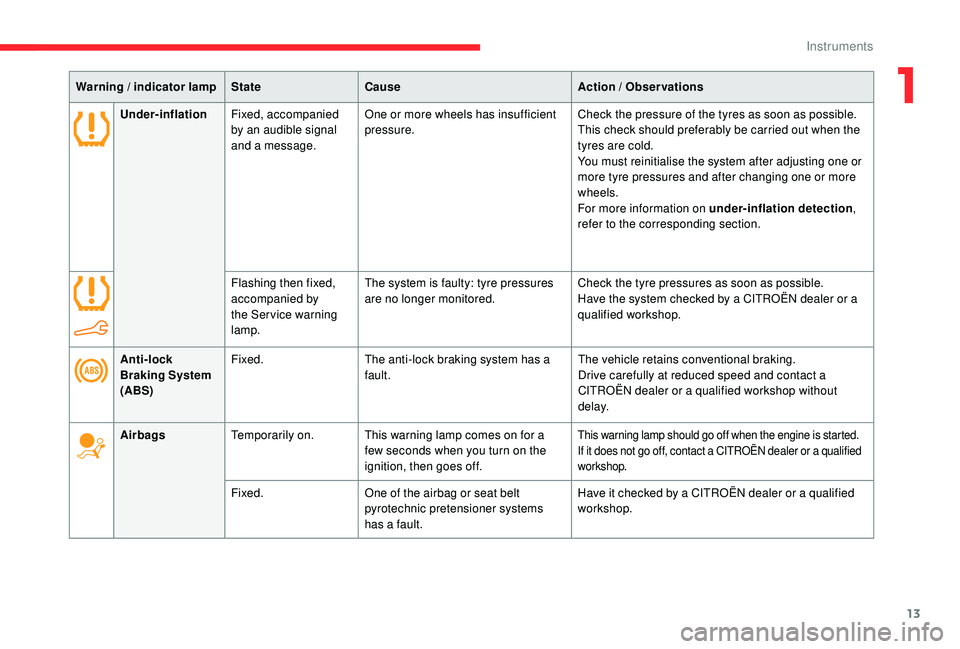
13
Under-inflationFixed, accompanied
by an audible signal
and a message. One or more wheels has insufficient
pressure.
Check the pressure of the tyres as soon as possible.
This check should preferably be carried out when the
tyres are cold.
You must reinitialise the system after adjusting one or
more tyre pressures and after changing one or more
wheels.
For more information on under-inflation detection
,
refer to the corresponding section.
Flashing then fixed,
accompanied by
the Ser vice warning
lamp. The system is faulty: tyre pressures
are no longer monitored.
Check the tyre pressures as soon as possible.
Have the system checked by a CITROËN dealer or a
qualified workshop.
Anti-lock
Braking System
(ABS) Fixed.
The anti-lock braking system has a
fault. The vehicle retains conventional braking.
Drive carefully at reduced speed and contact a
CITROËN dealer or a qualified workshop without
d e l ay.
Airbags Temporarily on. This warning lamp comes on for a
few seconds when you turn on the
ignition, then goes off.
This warning lamp should go off when the engine is started.
If it does not go off, contact a CITROËN dealer or a qualified
workshop.
Fixed.One of the airbag or seat belt
pyrotechnic pretensioner systems
has a fault. Have it checked by a CITROËN dealer or a qualified
workshop.
Warning / indicator lamp
StateCause Action / Observations
1
Instruments
Page 18 of 260
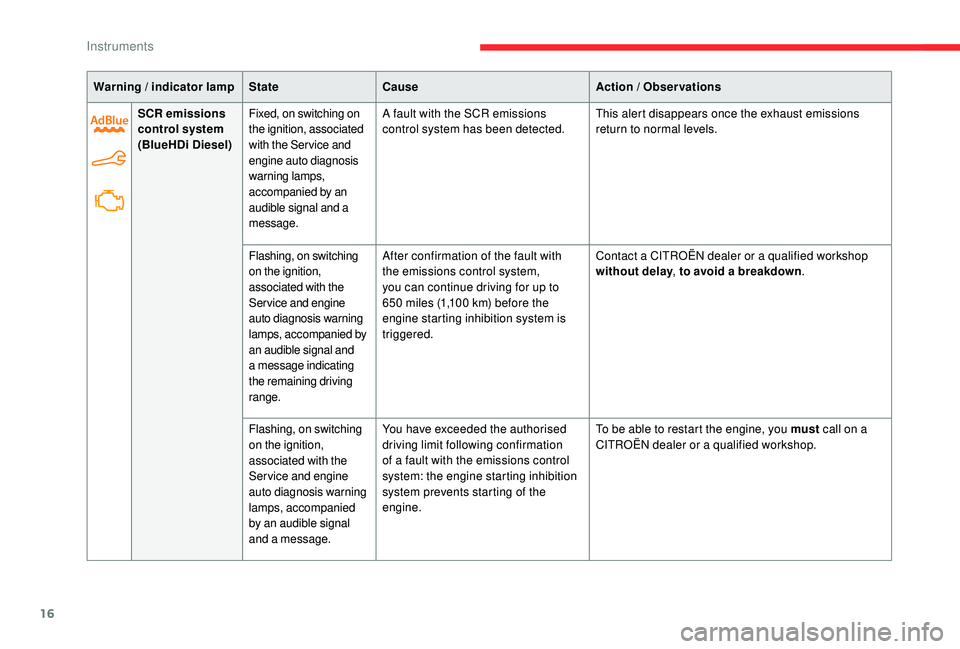
16
Warning / indicator lampStateCause Action / Observations
SCR emissions
control system
(BlueHDi Diesel) Fixed, on switching on
the ignition, associated
with the Ser vice and
engine auto diagnosis
warning lamps,
accompanied by an
audible signal and a
message. A fault with the SCR emissions
control system has been detected.
This alert disappears once the exhaust emissions
return to normal levels.
Flashing, on switching
on the ignition,
associated with the
Service and engine
auto diagnosis warning
lamps, accompanied by
an audible signal and
a message indicating
the remaining driving
range.After confirmation of the fault with
the emissions control system,
you can continue driving for up to
650
miles (1,100 km) before the
engine starting inhibition system is
triggered. Contact a CITROËN dealer or a qualified workshop
without delay
, to avoid a breakdown .
Flashing, on switching
on the ignition,
associated with the
Service and engine
auto diagnosis warning
lamps, accompanied
by an audible signal
and a message. You have exceeded the authorised
driving limit following confirmation
of a fault with the emissions control
system: the engine starting inhibition
system prevents starting of the
engine.
To be able to restart the engine, you must
call on a
CITROËN dealer or a qualified workshop.
Instruments
Page 20 of 260
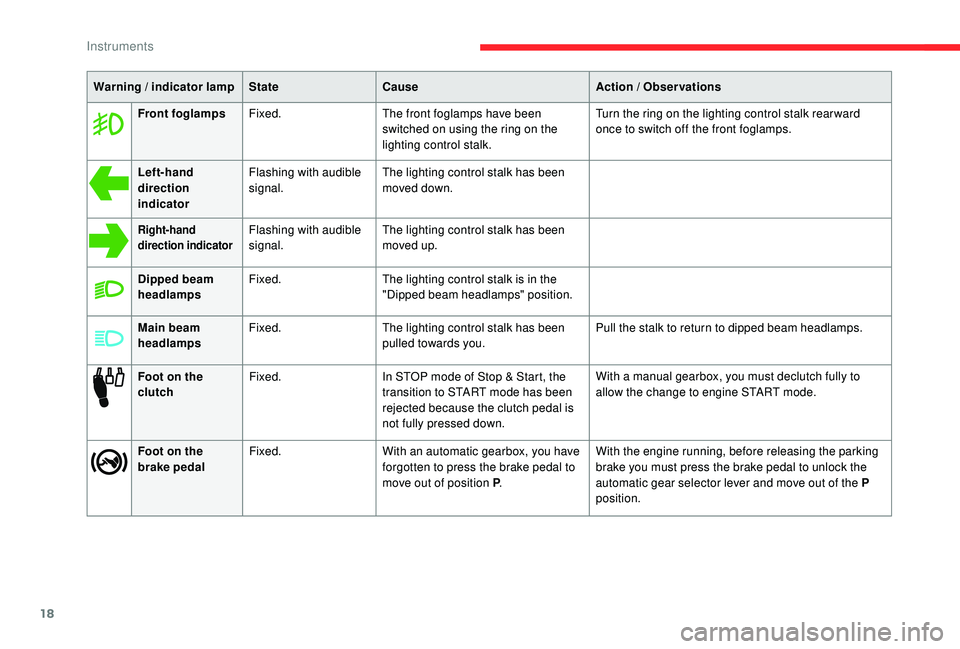
18
Warning / indicator lampStateCause Action / Observations
Front foglamps Fixed. The front foglamps have been
switched on using the ring on the
lighting control stalk. Turn the ring on the lighting control stalk rear ward
once to switch off the front foglamps.
Left-hand
direction
indicator Flashing with audible
signal.
The lighting control stalk has been
moved down.
Right-hand
direction indicatorFlashing with audible
signal.The lighting control stalk has been
moved up.
Dipped beam
headlamps Fixed.
The lighting control stalk is in the
"Dipped beam headlamps" position.
Main beam
headlamps Fixed.
The lighting control stalk has been
pulled towards you. Pull the stalk to return to dipped beam headlamps.
Foot on the
clutch Fixed.
In STOP mode of Stop & Start, the
transition to START mode has been
rejected because the clutch pedal is
not fully pressed down. With a manual gearbox, you must declutch fully to
allow the change to engine START mode.
Foot on the
brake pedal Fixed.
With an automatic gearbox, you have
forgotten to press the brake pedal to
move out of position P.With the engine running, before releasing the parking
brake you must press the brake pedal to unlock the
automatic gear selector lever and move out of the P
position.
Instruments
Page 32 of 260
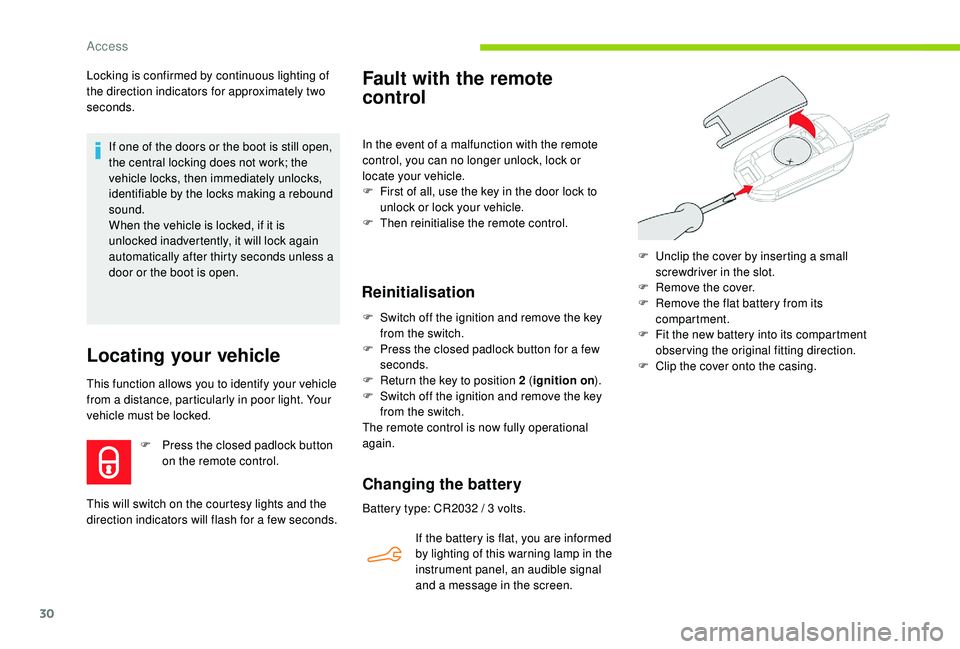
30
Locking is confirmed by continuous lighting of
the direction indicators for approximately two
seconds.If one of the doors or the boot is still open,
the central locking does not work; the
vehicle locks, then immediately unlocks,
identifiable by the locks making a rebound
sound.
When the vehicle is locked, if it is
unlocked inadvertently, it will lock again
automatically after thirty seconds unless a
door or the boot is open.
Locating your vehicle
This function allows you to identify your vehicle
from a distance, particularly in poor light. Your
vehicle must be locked. F
P
ress the closed padlock button
on the remote control.
This will switch on the courtesy lights and the
direction indicators will flash for a few seconds.
Fault with the remote
control
In the event of a malfunction with the remote
control, you can no longer unlock, lock or
locate your vehicle.
F
F
irst of all, use the key in the door lock to
unlock or lock your vehicle.
F
T
hen reinitialise the remote control.
Reinitialisation
F Switch off the ignition and remove the key from the switch.
F
P
ress the closed padlock button for a few
seconds.
F
R
eturn the key to position 2 (ignition on ).
F
S
witch off the ignition and remove the key
from the switch.
The remote control is now fully operational
again.
Changing the battery
Battery type: CR2032 / 3 volts.
I f the battery is flat, you are informed
by lighting of this warning lamp in the
instrument panel, an audible signal
and a message in the screen. F
U
nclip the cover by inserting a small
screwdriver in the slot.
F
R
emove the cover.
F
R
emove the flat battery from its
compartment.
F
F
it the new battery into its compartment
observing the original fitting direction.
F
C
lip the cover onto the casing.
Access
Page 35 of 260
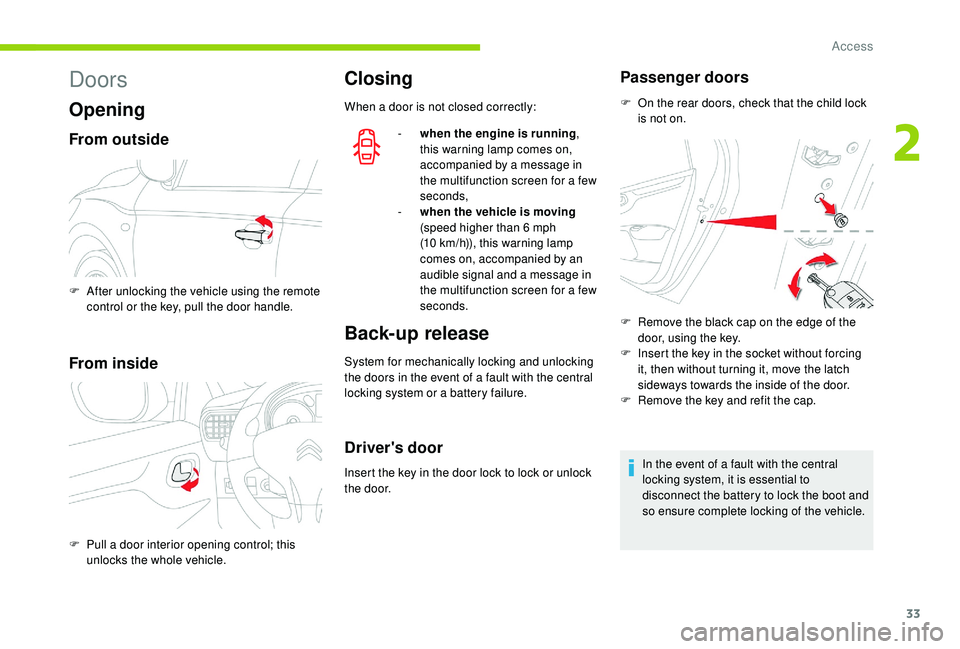
33
Doors
Opening
From outside
From inside
Closing
When a door is not closed correctly:-
w
hen the engine is running ,
this warning lamp comes on,
accompanied by a message in
the multifunction screen for a few
seconds,
-
w
hen the vehicle is moving
(speed higher than 6
mph
(10
km/h)), this warning lamp
comes on, accompanied by an
audible signal and a message in
the multifunction screen for a few
seconds.
Back-up release
System for mechanically locking and unlocking
the doors in the event of a fault with the central
locking system or a battery failure.
Driver's door
Insert the key in the door lock to lock or unlock
the door.
Passenger doors
F On the rear doors, check that the child lock is not on.
F
A
fter unlocking the vehicle using the remote
control or the key, pull the door handle.
F
P
ull a door interior opening control; this
unlocks the whole vehicle. F
R
emove the black cap on the edge of the
door, using the key.
F
I
nsert the key in the socket without forcing
it, then without turning it, move the latch
sideways towards the inside of the door.
F
R
emove the key and refit the cap.
In the event of a fault with the central
locking system, it is essential to
disconnect the battery to lock the boot and
so ensure complete locking of the vehicle.
2
Access
Page 54 of 260

52
Front foglamps and rear foglamp
Turn and release the ring:
F O nce for wards to switch the front foglamps
on.
F
A s
econd time for wards to switch the rear
foglamp on.
F
O
nce rearwards to switch the rear foglamp
of f.
F
A s
econd time rear wards to switch the front
foglamps off.
The foglamps and sidelamps remain on if the
dipped beams are switched off manually.
F
T
urn the ring rear wards to switch the
foglamps off; the sidelamps will then switch
of f. In good or rainy weather, both day and
night, using the front foglamps and the
rear foglamp is prohibited. In these
situations, the power of their beams may
dazzle other drivers. They should only be
used in fog or falling snow.
In these weather conditions, it is your
responsibility to switch on the foglamps
and dipped headlamps manually as the
sunshine sensor may detect sufficient
light.
Do not forget to turn off the front foglamps
and the rear foglamp as soon as they are
no longer necessary.
Switching off the lamps when the
ignition is switched off
On switching off the ignition, all of the
lamps turn off immediately, except for
the dipped beams if automatic guide-me-
home lighting is activated.
Switching on the lamps after switching
off the ignition
To reactivate the lighting control, rotate
the ring to the "0" position – lamps off,
then to the desired position.
When the driver's door is opened, a
temporary audible signal warns you that
the vehicle's lamps are on.
The lamps, with the exception of the
sidelamps, switch off automatically after
a maximum duration of thirty minutes to
prevent discharging of the battery.
Daytime running lamps
(Depending on the country of sale.)
When starting the vehicle, the daytime running
lamps come on automatically, if the lighting
control is in the "0" position.
The daytime running lamps go off
when the sidelamps and dipped
beam headlamps are switched on.
This function cannot be deactivated.
Lighting and visibility
Page 63 of 260

61
Anti-lock braking system
(ABS) and electronic brake
force distribution (EBFD)
The fixed illumination of this warning
lamp signals that there is a fault with
the ABS.
Illumination of this warning lamp,
coupled with the STOP and ABS
warning lamps, accompanied by
the display of a message and an
audible signal, signals that there is a
fault with the electronic brake force
distribution (EBFD).
Normal operation of the ABS may make
itself felt by slight vibration of the brake
pedal.
When braking in an emergency, press
firmly without ever releasing the
pressure. When changing wheels (tyres and rims),
ensure that these are approved for your
vehicle.Anti-slip regulation (ASR)
/ Dynamic stability control
(DSC)
Operation
These systems are activated automatically
every time the vehicle is started.
They come into operation in the event of a
problem of grip or trajectory.
Deactivation
In exceptional conditions (starting a vehicle
which is bogged down, stuck in snow, on soft
ground, etc.), it may be advisable to deactivate
these systems, so that the wheels can turn
freely and regain grip.
Reactivate the systems as soon as the level of
grip permits.
The vehicle retains conventional braking. Drive
carefully at moderate speed.
Contact a CITROËN dealer or a qualified
workshop as soon as possible.
You must stop as soon as it is safe to do so.
Call a CITROËN dealer or a qualified
workshop. This is indicated by this warning
lamp flashing in the instrument
panel.F
P
ress this button until the
corresponding symbol appears
in the instrument panel.
The button indicator lamp comes on.
The ASR and DSC systems will no longer have
an effect on engine operation or the brakes in
the event of an involuntary change of trajectory.
Reactivation
The ASR system is reactivated automatically
every time the ignition is switched back on or
from 30
mph (50 km/h).
Below 30
mph (50 km/h), you can reactivate it
manually.
F
P
ress this button again to
reactivate the system manually.
The button indicator lamp goes off.
5
Safety
Page 83 of 260
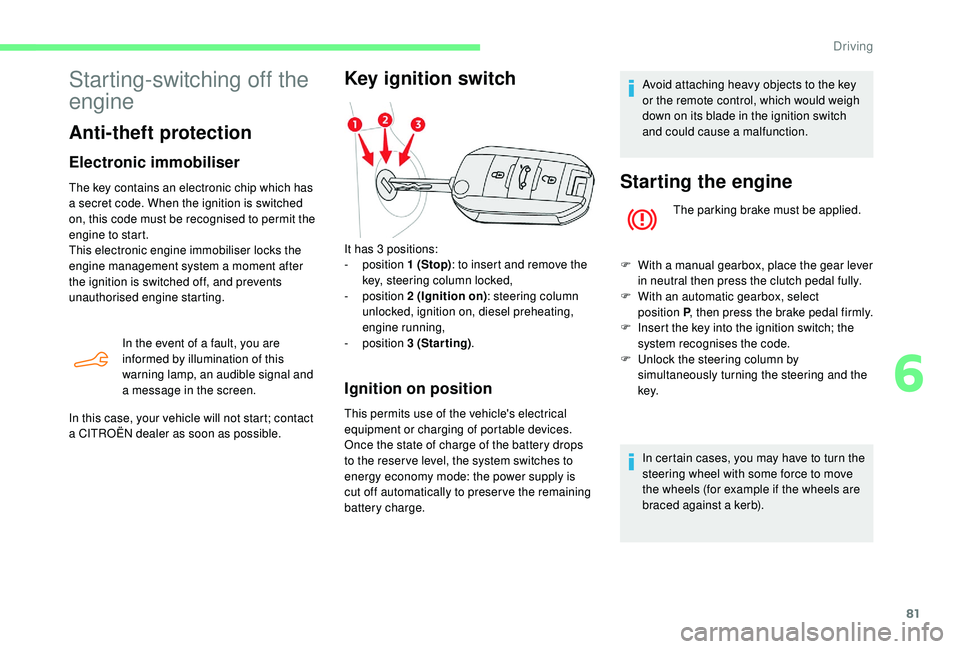
81
Starting-switching off the
engine
Anti-theft protection
Electronic immobiliser
The key contains an electronic chip which has
a secret code. When the ignition is switched
on, this code must be recognised to permit the
engine to start.
This electronic engine immobiliser locks the
engine management system a moment after
the ignition is switched off, and prevents
unauthorised engine starting.In the event of a fault, you are
informed by illumination of this
warning lamp, an audible signal and
a message in the screen.
In this case, your vehicle will not start; contact
a CITROËN dealer as soon as possible.
Key ignition switch
Ignition on position
This permits use of the vehicle's electrical
equipment or charging of portable devices.
Once the state of charge of the battery drops
to the reser ve level, the system switches to
energy economy mode: the power supply is
cut off automatically to preser ve the remaining
battery charge. Avoid attaching heavy objects to the key
or the remote control, which would weigh
down on its blade in the ignition switch
and could cause a malfunction.
Starting the engine
The parking brake must be applied.
F
W
ith a manual gearbox, place the gear lever
in neutral then press the clutch pedal fully.
F
W
ith an automatic gearbox, select
position P , then press the brake pedal firmly.
F
I
nsert the key into the ignition switch; the
system recognises the code.
F
U
nlock the steering column by
simultaneously turning the steering and the
key.
In certain cases, you may have to turn the
steering wheel with some force to move
the wheels (for example if the wheels are
braced against a kerb).
It has 3
positions:
-
position 1
(Stop) : to insert and remove the
key, steering column locked,
-
position 2
(Ignition on) : steering column
unlocked, ignition on, diesel preheating,
engine running,
-
position 3
(Starting) .
6
Driving
Page 85 of 260
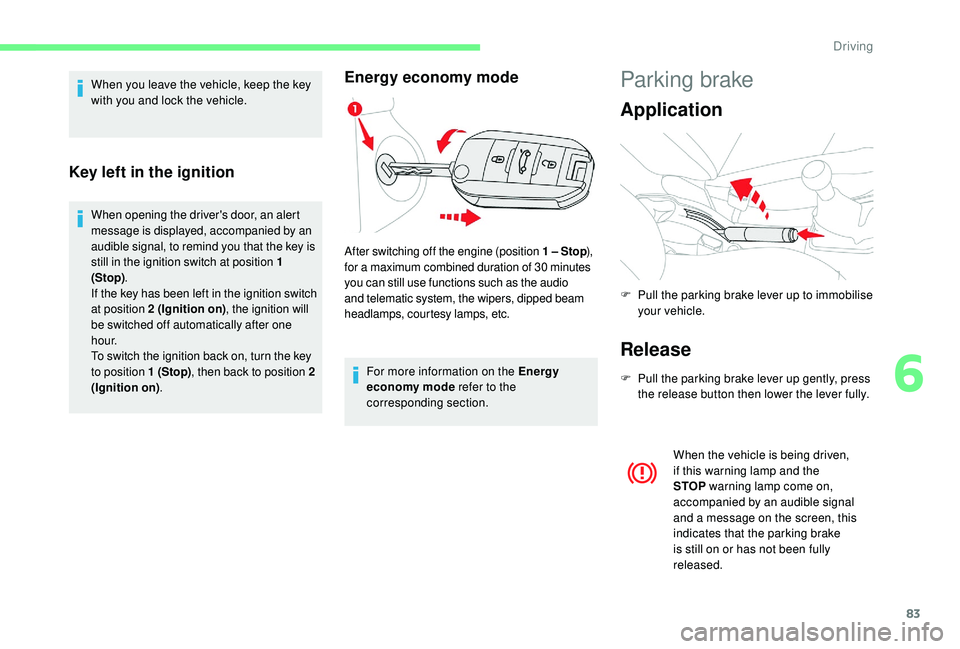
83
When you leave the vehicle, keep the key
with you and lock the vehicle.
Key left in the ignition
When opening the driver's door, an alert
message is displayed, accompanied by an
audible signal, to remind you that the key is
still in the ignition switch at position 1
(Stop).
If the key has been left in the ignition switch
at position 2
(Ignition on) , the ignition will
be switched off automatically after one
h o u r.
To switch the ignition back on, turn the key
to position 1
(Stop), then back to position 2
(Ignition on) .
Energy economy mode
For more information on the Energy
economy mode refer to the
corresponding section.
After switching off the engine (position 1 – Stop
),
for a maximum combined duration of 30 minutes
you can still use functions such as the audio
and telematic system, the wipers, dipped beam
headlamps, courtesy lamps, etc.
Parking brake
Application
Release
F Pull the parking brake lever up gently, press the release button then lower the lever fully.
When the vehicle is being driven,
if this warning lamp and the
STOP warning lamp come on,
accompanied by an audible signal
and a message on the screen, this
indicates that the parking brake
is still on or has not been fully
released.
F
P
ull the parking brake lever up to immobilise
your vehicle.
6
Driving
Page 87 of 260

85
Displays in the instrument panelFoot on the brake pedal
F Press the brake pedal when this warning lamp is displayed in the
instrument panel (e.g. starting
the engine).
Moving off
Automatic operation
F Select position D for automatic changing of
the six gears.
The gearbox then operates in auto-adaptive
mode, without any action needed from the
driver. It continuously selects the most suitable
gear according to the style of driving, the profile
of the road and the load in the vehicle.
F
A
pply the parking brake.
F
Sel
ect position P or N
.
F
S
tart the engine.
If these conditions are not met, you will hear an
audible signal, associated with the display of a
warning message.
F
W
ith the engine running, press the brake
pedal.
F
R
elease the parking brake.
F
Sel
ect position R
, D or M.
F
G
radually release the brake pedal.
The vehicle moves off immediately.
If position N is selected inadvertently while
driving, allow the engine to return to idle
then select position D before accelerating. If the exterior temperature is below -23°C,
the engine should be left at idle for four
minutes, to ensure the correct operation
and life of the engine and gearbox.
When the engine is running at idle with the
brakes released, if position R
, D or M is
selected, the vehicle moves even without
the accelerator being pressed.
Never leave children unsuper vised in the
vehicle when the engine is running.
When carrying out maintenance with the
engine running, apply the parking brake
and select position P .
When you move the selector to select a
position, the corresponding indicator is
displayed in the instrument panel.
P.
Park.
R. Reverse.
N. Neutral.
D. Drive.
S. Sport programme.
T . Snow
programme.
1
2
3
4
5
6.
Gears engaged during manual
operation.
-. Invalid value during manual
operation.
6
Driving